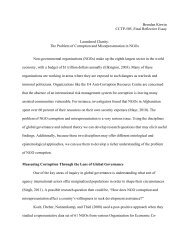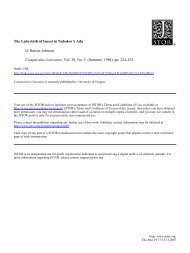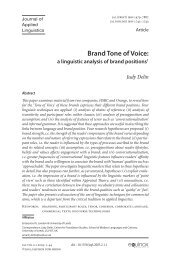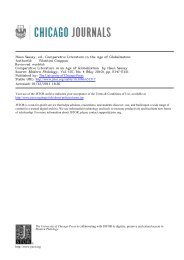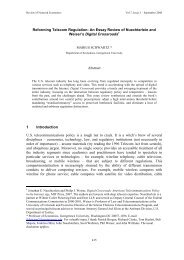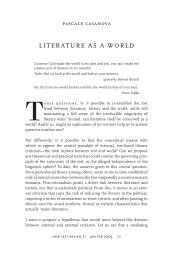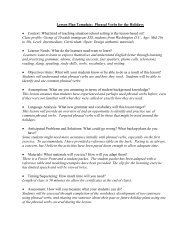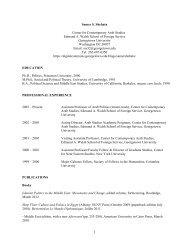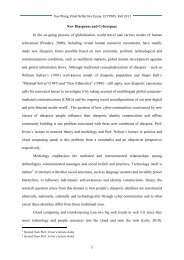roote-prokop-2013-g3-drosophila-genetics-training-all
roote-prokop-2013-g3-drosophila-genetics-training-all
roote-prokop-2013-g3-drosophila-genetics-training-all
Create successful ePaper yourself
Turn your PDF publications into a flip-book with our unique Google optimized e-Paper software.
enormous breadth of genetic tools and strategies available in the fly,<br />
ranging from Mendelian rules and their Drosophila-specific aspects to<br />
sophisticated recombination-based strategies for the generation of<br />
mutant <strong>all</strong>eles or mosaic tissues. Accordingly, <strong>genetics</strong> <strong>training</strong> is<br />
a key requirement in Drosophila research groups. All those joining<br />
the laboratory without fly experience, including postdocs, PhD students,<br />
technical staff, and undergraduate project students, have to go<br />
through the bottleneck of the initial <strong>training</strong> that provides them with<br />
sufficient understanding of Drosophila <strong>genetics</strong> and the breadth of<br />
genetic tools that are in daily use in most fly laboratories. Only<br />
through this <strong>training</strong> will they start functioning in their daily routine,<br />
achieve a certain level of independence in their experimental work,<br />
and be able to comprehend advanced information resources to develop<br />
a greater degree of sophistication. Training new laboratory<br />
members or project students in fly <strong>genetics</strong> is time-consuming and<br />
demanding for the trainer yet too important to be left to chance.<br />
Considering the size of the Drosophila community and its longstanding<br />
history, there is surprisingly little <strong>training</strong> material publicly<br />
available. Currently, excellent books are on hand to help the partly<br />
trained fly researcher to advance to the next step of expert knowledge<br />
in fly handling and advanced <strong>genetics</strong> (Ashburner et al. 2005; Dahmann<br />
2008; Greenspan 2004). However, these resources do not answer seemingly<br />
trivial questions that a complete novice is initi<strong>all</strong>y faced with, often<br />
concerning very basic aspects of Mendelian rules in the fly, genetic<br />
terminology and gene names, marker mutations and balancers, the<br />
various classes of transgenic flies, and the principal strategies for their<br />
generation. A thorough “starter package” that provides an overview of<br />
these fundamental aspects of fly <strong>genetics</strong>iscurrentlynotavailable.<br />
Here we present such a <strong>training</strong> package. It was developed over<br />
many years of teaching Drosophila mating schemes to undergraduate<br />
students and, since 2009, has been adapted and successfully established<br />
as a standard procedure to train new group members joining<br />
the Manchester fly facility. This package is composed of four individual<br />
modules, including self-study of an introductory manual, a short<br />
practical session on gender and marker selection, an interactive<br />
PowerPoint presentation, and fin<strong>all</strong>y independent <strong>training</strong> exercises<br />
in mating scheme design. Furthermore, a genotype builder is provided<br />
to help trainers generate fly images for their <strong>training</strong> tasks, useful also<br />
to illustrate presentations or publications.<br />
THE TRAINING PACKAGE<br />
Key rationale and flow chart of the <strong>training</strong><br />
Training newcomers to fly <strong>genetics</strong> is a far more complex task than is<br />
often appreciated by the experienced fly researcher. We may take it for<br />
granted that the importance of Drosophila is appreciated, that basic<br />
rules of Mendelian <strong>genetics</strong> are known to trainees, or that it is clear<br />
why we have to use mating schemes during our daily work. These<br />
suppositions often do not reflect reality. From our own experience, we<br />
identified a number of objectives that need to be achieved in basic fly<br />
<strong>genetics</strong> <strong>training</strong>:<br />
• a basic appreciation of why the fly is being used for research;<br />
• an understanding of why genetic crosses are required, what the<br />
nature of the involved fly stocks is (including classical <strong>all</strong>eles as well<br />
as transgenic fly lines), and why crosses need to be carefully<br />
planned through mating scheme design;<br />
• an understanding of classical genetic rules, including the law of<br />
segregation, the law of independent assortment, and the nature of<br />
linkage groups and meiotic crossing-over—<strong>all</strong> in the context of<br />
Drosophila <strong>genetics</strong>;<br />
• a knowledge of the nature and use of genetic markers and balancer<br />
chromosomes and how they are used for stock keeping and the<br />
unequivocal tracing of chromosomes within a mating scheme;<br />
• an appreciation of genetic recombination as a threat but also experimental<br />
opportunity and how to manage recombination in mating<br />
schemes.<br />
To meet these objectives we developed, as the first <strong>training</strong><br />
module, a “Rough guide to Drosophila mating schemes” (Supporting<br />
Information, File S1). This manual is studied independently by trainees<br />
and prepares them for the rationale, rules, terminology, and genetic<br />
tools they are confronted with during the next steps of the<br />
<strong>training</strong>. Notably, it <strong>all</strong>ows the trainees to ask informed questions<br />
and better engage in the further <strong>training</strong> process.<br />
As the next step, we find it useful to provide the trainee with a brief<br />
practical <strong>training</strong> session on basic gender and marker selection. A<br />
simple <strong>training</strong> exercise (File S2) is provided that helps trainees to<br />
compare marker mutations of flies in reality with those used as images<br />
in the <strong>training</strong> modules. This short practical enhances the experience<br />
of the further <strong>training</strong> and makes it easier to link theory to practice.<br />
A PowerPoint presentation is used as the next self-study module<br />
(File S3). It briefly reminds trainees of the key rules and facts before<br />
engaging in a detailed step-by-step guided tour through the design of<br />
a problem-driven mating scheme. This presentation demonstrates<br />
how the learned theory is applied during mating scheme design.<br />
Up to this point, most <strong>training</strong> is performed through self-study<br />
and does not require more input than the brief <strong>training</strong> session in<br />
gender and marker selection and answering occasional queries.<br />
Therefore, these modules enormously reduce the time invested in<br />
<strong>training</strong> but also spare the trainees the need to ask naive or basic<br />
questions that may be perceived as embarrassing.<br />
After this initial self-<strong>training</strong>, trainees are asked to solve genetic<br />
tasks reflecting simple day-to-day problems experienced in a fly<br />
laboratory (File S4). Trainees try to carry out this task independently<br />
but are encouraged to seek help in two ways. First, they<br />
should revisit the other <strong>training</strong> modules because information<br />
given in manual and presentation consolidates and becomes<br />
clearer when it is actively applied during mating scheme design.<br />
Second, trainees are invited to ask the trainer focused questions<br />
whenever necessary. Through this, trainees and teachers have<br />
a unique opportunity to identify which aspects of the <strong>training</strong> were<br />
well understood and where strengths and weaknesses lie for each<br />
individual trainee. These can then be tackled through discussion<br />
and reiteration of the learned material, thus achieving the basic<br />
<strong>training</strong> objective.<br />
The “rough guide to Drosophila mating schemes”<br />
(one day of trainee’s time)<br />
The “rough guide to Drosophila mating schemes” (File S1) is handed<br />
out to trainees for initial self-study. It covers a wide range of topics,<br />
each based on a clear rationale.<br />
The first section provides the key arguments for using flies and<br />
provides a brief historical perspective. For the young researcher, it is<br />
not necessarily clear why work on the fly may be important, especi<strong>all</strong>y<br />
in times when mouse or zebrafish <strong>genetics</strong> have become very powerful<br />
and where human disease has become a central topic in biomedical<br />
research. Understanding the roots of Drosophila <strong>genetics</strong> and how it<br />
contributed to subsequent scientific successes is key for appreciating<br />
the unbroken value of fly work in modern biology. References are<br />
provided to substantiate the arguments and encourage further reading.<br />
354 | J. Roote and A. Prokop



